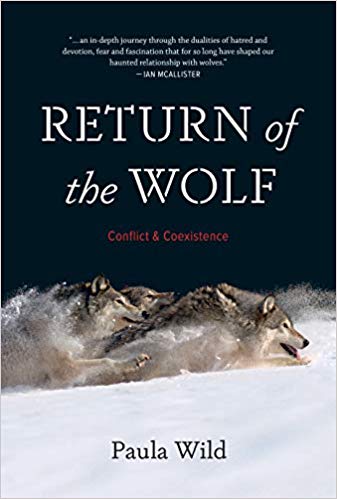
Return of the Wolf: Conflict and Coexistence
Review By K R Jones
July 23, 2019
BC Studies no. 204 Winter 2019/20 | p. 209-210
In his famous study Of Wolves and Men (1978), Barry Lopez pertinently noted that ‘the wolf exerts a powerful influence on the human imagination. It takes your stare and turns it back on you.’ Paula Wild’s new book, Return of the Wolf eagerly demonstrates that, forty-ish years after Lopez’s classic exposition, we are still equally (perhaps even more) enthralled by Canis lupus.
A Courtenay-based nature writer with a proven track record of publication on large canids (The Cougar (2013)), Wild offers here an engaging study of a captivating and endlessly reinvented species over millennia, tracked both through animal biology and a long testimonial trail of human-animal encounter. As she points out, wolves share a domestic lineage with the dog, but stand also as a modal binary, a carrier for the ‘wild’ in all its fearsome and attractive capacities. More than any other animal, Wild contends, the wolf has become embedded in our psyche (p.4). Breathless in its scope, informed, and certainly readable, Return of the Wolf tracks this story through Greek mythology and across the Russian Steppes in ‘The Big Bad Wolf of the Old World,’ before turning to a New World human-lupine entanglement as expressed through the likes of Cherokee storytellers and the fireside yarns of nineteenth-century wolf bounty hunters. We learn, too, much about ‘the life of the wolf’ – its eating and sensory habits – as well as of the complex negotiations that have taken place in areas where wolves have returned (either through their agency or government reintroduction programmes) to ancestral haunts.
A blend of natural history, indigenous folk tales and personal anecdotes, this book spends considerable time exploring the social dynamics of the pack, debunking some of the hoary misconceptions about wolves along the way. As such, it presents a useful focus on the animal itself, as well as chronicling the diverse ways in which different communities have treated wolves across a global stage. The range is expansive and the writing spirited (if necessarily broad-brush in its historical explanations). Dominant in the latter is an exploration of the paradigms of reverence (typically associated with indigenous communities and conservationists) and revilement (espoused, most often, by architects of European colonisation and those living up close with Canis lupus in areas of ranching or pastoral subsistence). The subtitle to Wild’s study, Conflict and Coexistence is a helpful anchor in communicating this story of misunderstanding and territorial collisions (though it is at times a little simple in its declentionist treatment of science as an objective bodyguard to public sentiment). Throughout, the wolf appears as a resilient and adaptable species. Homo sapiens, on the other hand, comes across as rather less benign and certainly inflexible. Even today, with Canis lupus enshrined as the alpha symbol of environmentalism, as Return of the Wolf notes, there remains a sense of what Wild nicely phrases as ‘primal uneasiness’ (p.7) about their up-close presence. Her guiding question is thus a salient one: can humans adapt to wolves?
Publication Information
Return of the Wolf: Conflict and Coexistence Paula Wild
Madeira Park: Douglas & McIntyre, 2018. 272 pp. $32.95 hardcover
